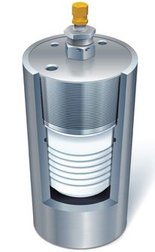 Installation and maintenance tips for Blacoh pulsation dampeners
Installation and maintenance tips for Blacoh pulsation dampeners
May 31, 2016 REDWIRE is news you can use from leading suppliers. Powered by FRASERS.
Posted by York Fluid Controls Ltd
Is a leading stocking distributor of fluid transfer and process pumps, positive displacement and centrifugal pumps, liqu... Read more
Subscribe
Free REDWIRE e-newsletter

A wide range of Blacoh pulsation dampeners are available from York Fluid Controls. These pulsation dampeners can remove virtually all hydraulic shock from pumping systems. The result is enhanced all-around performance and reliability. They will protect pipes, valves, meters, fittings and in-line instrumentation from surges, pulsations, cavitation, water hammer and thermal expansion. In addition, they are easy to install and require very little maintenance.
Installation tips
When choosing the installation location, place the pulsation dampener within 10 pipe diameters of the pressure fluctuation source, depending on the application. The dampener can be installed at the pump discharge to provide pulsation dampening, at the pump inlet for inlet stabilizing, upstream of a valve for handling water hammer, and at a centrifugal pump discharge for startup or shutdown.
Blacoh pulsation dampeners can be installed in a vertical, horizontal or upside-down position, since pressure is equal in all directions. But a vertical installation is recommended to achieve the best drainage of dampeners. Horizontal and upside-down mounting can be limited by high viscosity, high specific gravity, settling of solid material, or air entrapment. These issues could lead to shortened life and reduced performance.
Maintenance tips
Very little maintenance is required for pulsation dampeners. That is because there is only one wear part: the elastomeric bladder or PTFE bellows, depending on the type. They do not even need lubrication. However, elastomeric bladders should be replaced as part of a preventative maintenance program. If the pulsation dampener is used in conjunction with a diaphragm pump, the bladder should be replaced every second time the pump diaphragms are replaced. The pulsation dampener and fasteners should also be inspected periodically for visual signs of over-pressurization, stress, fatigue or corrosion.
When installing or reinstalling a pulsation dampener, refer to the installation and operation manual for fastener torque specifications, as they vary depending on the model. Do not reuse old nuts and bolts, because re-torquing can cause them to lose up to 20 per cent of their strength. If the dampener is used in a corrosive environment, the fasteners should be regularly inspected.
For more information, contact York Fluid Controls.
Share
Posted by York Fluid Controls Ltd
Is a leading stocking distributor of fluid transfer and process pumps, positive displacement and centrifugal pumps, liqu... Read more
